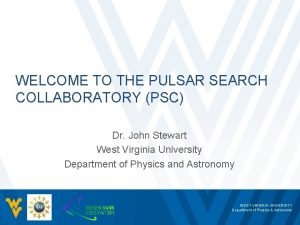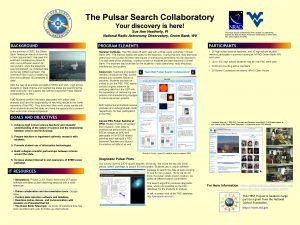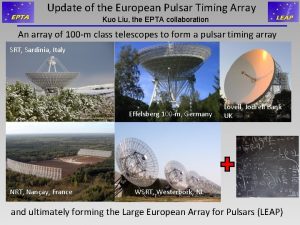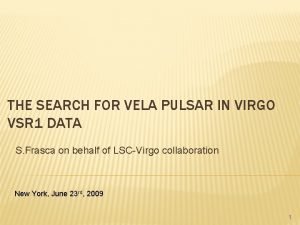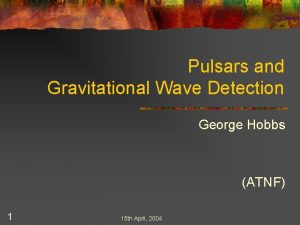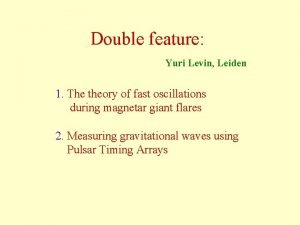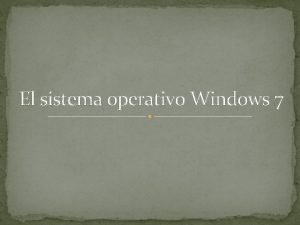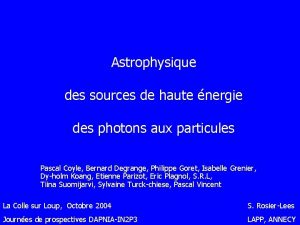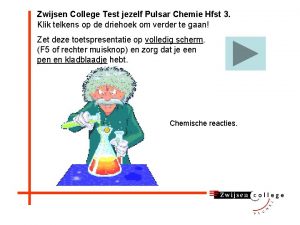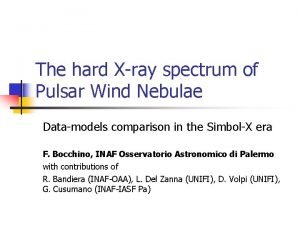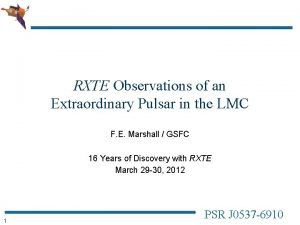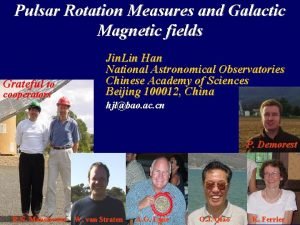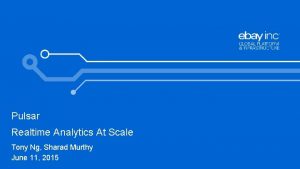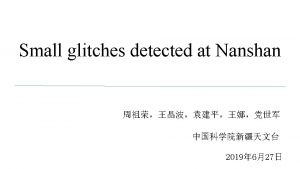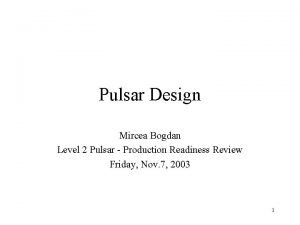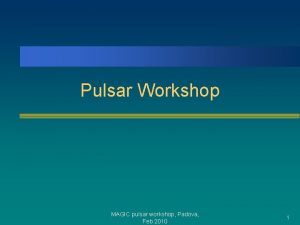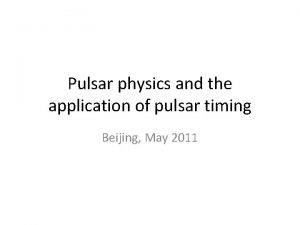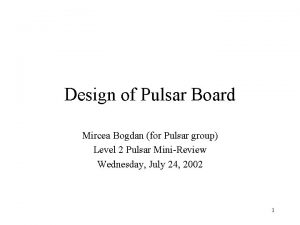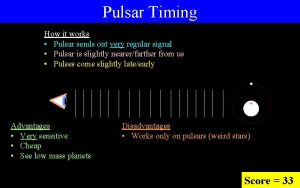S 3 time domain known pulsar search Rejean














- Slides: 14

S 3 time domain known pulsar search Rejean Dupuis, Matthew Pitkin and Graham Woan for the LSC meeting, Univ. of Michigan 04/06/05 1

The story so far … • We have previously been searching for known isolated pulsars with frequencies > 25 Hz (GW freq > 50 Hz) • S 2 produced upper limits for gravitational wave amplitude and neutron star ellipticity from 28 pulsars (PRL, 2005) • We know the positions and spindown parameters of these objects well from radio observations • However there are more pulsars (82) with freqs > 25 Hz, most within binary systems … LSC meeting, Univ. of Michigan 04/06/05 2

Pulsars f > 25 Hz Preliminary results (74) Awaiting timing data (36) • For S 3 the main change has been adding code to take account of Doppler shifts in the binary systems J 0024 -7204 C J 0218+4232 J 1537+1155 J 1745 -0952 J 1918 -0642 J 0024 -7204 D J 0437 -4715 J 1603 -7202 J 1748 -2446 A J 1939+2134 J 0024 -7204 E J 0514 -4002 A J 1618 -39 J 1748 -2446 C J 1952+3252 J 0024 -7204 F J 0534+2200 J 1623 -2631 J 1757 -5322 J 1955+2908 J 0024 -7204 G J 0537 -6910 J 1629 -6902 J 1804 -0735 J 1959+2048 J 0024 -7204 H J 0613 -0200 J 1640+2224 J 1804 -2717 J 2019+2425 J 0024 -7204 I J 0621+1002 J 1641+3627 A J 1807 -2459 J 2033+17 J 0024 -7204 J J 0635+0533 J 1641+3627 B J 1810 -2005 J 2051 -0827 J 0024 -7204 L J 0711 -6830 J 1643 -1224 J 1823 -3021 A J 2124 -3358 J 0024 -7204 M J 0737 -3039 A J 1701 -3006 A J 1824 -2452 J 2129+1210 D J 0024 -7204 N J 0751+1807 J 1701 -3006 B J 1843 -1113 J 2129+1210 E J 0024 -7204 O J 1012+5307 J 1701 -3006 C J 1857+0943 J 2129+1210 F J 0024 -7204 P J 1022+1001 J 1701 -3006 D J 1905+0400 J 2129+1210 G J 0024 -7204 Q J 1024 -0719 J 1701 -3006 E J 1909 -3744 J 2129+1210 H J 0024 -7204 R J 1045 -4509 J 1701 -3006 F J 1910+0004 J 2129 -5721 J 0024 -7204 S J 1300+1240 J 1709+2313 J 1910 -5959 A J 2130+1210 C J 0024 -7204 T J 1312+1810 J 1713+0747 J 1910 -5959 B J 2140 -2310 A J 0024 -7204 U J 1420 -5625 J 1721 -2457 J 1910 -5959 C J 2140 -23 B J 0024 -7204 V J 1435 -6100 J 1730 -2304 J 1910 -5959 D J 2145 -0750 J 0024 -7204 W J 1455 -3330 J 1732 -5049 J 1910 -5959 E J 2229+2643 J 0030+0451 J 1518+0205 A J 1740 -5340 J 1911 -1114 J 2317+1439 J 0034 -0534 J 1518+0204 B J 1744 -1134 J 1913+1011 J 2322+2057 LSC meeting, Univ. of Michigan 04/06/05 3

Binary pulsar signal • In a binary system we need to take account of the pulsar motion within that system • This adds extra terms to timing equivalent to those for the solar system Aberration delay (caused by pulsar rotation) Roemer deley (light travel time) • These time delays are parameterised by various measurable properties of the binary system (period P, eccentricity e, angular velocity w, time of periastron T, projected semi-major axis asini etc) • There also other (model dependent) relativistic parameters LSC meeting, Univ. of Michigan 04/06/05 4

Binary pulsar models • 70 binary pulsars fall mainly into two model categories – – 32 ELL 1 (low eccentricity) 33 BT (Blandford-Teukolsky) 1 BT 2 P (two orbiting planets) 4 DD (Damour-Deruelle) including double pulsar binary J 0737 -3039 A • We have orbital parameters solutions over S 3 for the majority of these pulsars from Andrew Lyne and Michael Kramer, Jodrell Bank. LSC meeting, Univ. of Michigan 04/06/05 5

Pulsar 11 – model and heterodyned output Code testing • Code has been written to calculate time delay with the three models BT, ELL 1 and DD • As we did for the solar system barycentring code, we have checked this against TEMPO • Code has been tested against radio pulsar data with good agreement • Two binary pulsars injected into end of S 4 have been successfully extracted LSC meeting, Univ. of Michigan 04/06/05 Pulsar 10 6

Analysis • Analysis proceeds as for S 2: – Heterodyne to remove Dopper/spindown effects (including binary parameters where needed) – Joint Bayesian analysis for unknown pulsar parameters, h 0, f 0, y and cosi using data (of unknown variance) from three LIGO interferometers LSC meeting, Univ. of Michigan 04/06/05 7

Preliminary Results Pulsars 5 e-25 < h 0 < 1 e-24 5 e-24 < h 0 < 1 e-23 16 52 4 h 0 > 1 e-23 2 1 e-24 < h 0 < 5 e-24 All values assume I = 1038 kgm 2 and no error on distance • Several of these could be astrophysically interesting given exotic neutron star equations of state (B. Owen, submitted to PRL) • 31 pulsars are in globular clusters so spin-down is masked by Doppler motion within cluster (20 with apparent spin-up) Ellipticity Pulsars 1 e-6 < e < 5 e-6 7 5 e-6 < e < 1 e-5 16 1 e-5 < e < 1 e-4 40 e > 1 e-4 11 LSC meeting, Univ. of Michigan 04/06/05 8 Proposed for Amaldi h 0

Selected preliminary results Proposed for Amaldi • Lowest h 0 upper limit: – PSR J 1910 -5959 B (fgw = 239. 3 Hz, dist = 2. 15 kpc) h 0 = 5. 3 e-25 • Lowest ellipticity upper limit – PSR J 2124 -3358 (fgw = 405. 6 Hz, dist = 0. 25 kpc) e = 1. 5 e-06 • Closest to spin-down upper limit – Crab pulsar ~ 5 times greater than spin-down (fgw = 59. 6 Hz, dist = 2. 0 kpc) – h 0 = 6. 5 e-24, e = 3. 5 e-3 – Assumes I = 1038 kgm 2 Crab pulsar LSC meeting, Univ. of Michigan 04/06/05 9

I-e plane • Crab pulsar – 2. 0 kpc Moment of inertia Izz • We do not really know neutron stars’ moment of inertia – so far we’ve been using the canonical value. Rather than use the upper limit on h 0 to set a limit on e we can instead use it as an upper limit on the quadrupole moment , Ie. This can then be plotted on a I-e plane providing exclusion regions on both the moment of inertia and ellipticity. Proposed for Amaldi • LSC meeting, Univ. of Michigan 04/06/05 10

Pulsar 3 S 3 injections Pulsar 4 LSC meeting, Univ. of Michigan 04/06/05 11 Proposed for Amaldi • 10 pulsar injections were performed in S 3 over large range of signal amplitudes and parameters • Injections have been recovered with the correct parameters (after calibration corrections)

S 3 results - astrophysics LSC meeting, Univ. of Michigan 04/06/05 12 Proposed for Amaldi • Whilst our upper limits for these pulsars are generally well above those permitted by spin-down constraints and neutron star equations-of-state they have some astrophysical interest. • We provide the first direct upper limits on gravitational wave emission for 46 of the 74 pulsars, now including binaries. • For the 25 globular cluster pulsars we provide the limits independent of the cluster dynamics. • Our most stringent ellipticities (1. 5 e-6) are starting to reach into the range permitted by at least one exotic theory of neutron star structure (B. Owen, submitted to PRL). • The Crab pulsar is nearing the spin-down upper limit (with a couple of others only ~100 times greater e. g. binary pulsar J 0737 -3039 A)

Proposed for Amaldi • Presentation of S 3 LIGO results for 74 pulsars – thoroughly check input files and parameters – get more radio data to confirm binary code – check on possible Crab glitch during S 3 • Presentation of S 3 pulsar hardware injections – results are now well understood • Present joint GEO analysis for fastest pulsars – check that GEO adds to the analyses LSC meeting, Univ. of Michigan 04/06/05 13

Future work • Near term – Complete final review of S 3 results – Perform S 4 analysis • coherent analysis with S 3 (S 2 as priors? ) • Long term – Rewrite software for “real time” S 5 analysis (or at least speed up/optimise the code a lot) LSC meeting, Univ. of Michigan 04/06/05 14
